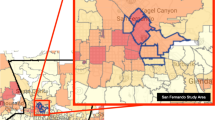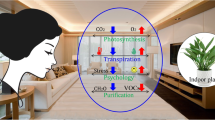Abstract
The intensity of the sunlight reflected by the snow-covered surfaces is so high that it may disturb humans many times. This study aims to determine the reflected sunlight intensities from snow covered areas at points near (at a distance of 2 m) and under an individual tree and among trees (in the forest area) by accepting the open area as control; the reducing effects of the plant materials on reflected sunlight in percentage by comparing with the values of the open (control) area; and critical reflected sunlight threshold values for human visual comfort. The study was carried out over 22 clear and calm, i.e. sky was cloudless and wind was calm, days between the 1st and 31st days of January 2004, at 8:30 in the morning, at 12:30 at noon and at 14:30 in the afternoon in Erzurum. In order to determine the discomforting light intensity levels, 25 females and 26 male (totally 51) student subjects whose mean age was 20 and who had no visual disorders were selected. Considering the open area as control, mean reflected sunlight reducing effects were found to be 19.0, 66.0 and 82.7% for the 2 m near a tree, under a tree, and forest area, respectively. According to the responses of 51 subjects in the study, visually “very comfortable” range is between 5,000 and 8,000 lx; “comfortable” range is between 11,000 and 75,000 lx (mostly at 12,000 lx); “uncomfortable” condition is above the light intensity value of 43,000 lx and “very uncomfortable” condition is above the intensity of 80,000 lx. Great majority of the subjects (91%) found the value of 103,000 lx to be “very uncomfortable.” As it is not an applicable way to use the great and dense tree masses in the cities, at least individual trees should be used along the main pedestrian axels in the cities having the same features with Erzurum to prevent the natural light pollution and discomforting effects of the snow-reflected sunlight.
Similar content being viewed by others
References
Agaoglu, S., Celik, H., Celik, M., Fidan, Y., Gulsen, Y., Gunay, A., et al. (1995). Common Garden Plants. Ankara University, Agricultural Faculty, Education, Research and Development Association Publications No: 4, Ankara.
Akbari, H. (2002). Shade trees reduce building energy use and CO2 emissions from power plants. Environmental Pollution, 116(1), 119–126.
Akbay, R. (1982). Scientific poultry (p 182). Ankara: Guven Press.
Akyurt, I. (1993). Fishery Nutrition. Ataturk University, Agricultural Faculty Textbooks, No: 156, pp 220, Erzurum.
Amato, Y. F. (2007). Suggestions to the skiers. Turkey: Diva Magazine Journal.
Andic, C. (1993). Agricultural Ecology. Ataturk University Agricultural Faculty Textbooks, No: 106, pp: 300, Erzurum.
Anonymous. (2002). The Meteorology Service of Erzurum.
Aslan, Z. (2001). Light Pollution. Light Pollution and Dark-Sky Meeting, 16th November 2001, Antalya.
Aslanboga, I. (2002). Principles of Planting by Woody Plants. Turkish State Forestry Ministry, Aegean Forestry Research Management Publications, Izmir.
Barbour, M. G., Burk, J. H., & Pitts, W. D. (1987). Terrestrial plant ecology. The Benjamin/ Cummings Publishing Company, Inc 2727 Sand Hill Road, California 94025.
Bedunah, D. J., & Soseebee, R. E. (1995). Woodland plants: physiological ecology and developmental morphology. Society for Range Management 1839 York Street Denver, Colorado 80206.
Bernatzky, A. (1982). The contribution of trees and green spaces to a town climate. Energy and Buildings, 5(1), 1–10.
Bouchair, A. (2004). Decline of urban ecosystem of Mzab valley. Building and Environment, 39(6), 719–732.
Cinzano, P., Falchi, F., & Elvidge, C. D. (2001). Moonlight without the moon. Earth Moon and Planets, 85(6), 517–522.
Demircioglu, N., & Yılmaz, H. (2005). Light pollution; the problems it causes and solutions proposals. Ataturk University. Journal of Agriculture Faculty, 36(1), 117–123.
Di Sora, M. (2001). Plan of the modification of public lighting in frosione in accordance with the rule for the limitation of Light pollution and power conception. Preserving the Astronomical Sky. IUA Symposia, 196, 126–129.
Dutil Y., 2001. Light pollution in Quebec. Preserving the astronomical sky. International Astronomical Union Symposıa 196, pp:134–137, http://www.iau.org/.
Ebbesson, L., Ekström, P., Ebbesson, S., Stefensson, S., & Holmqvist, B. (2003). Neural circuits and their structural and chemical reorganization in the light-brain-pituitary axis during parr-smolt transformation in salmon. Aquaculture, 62349, 1–12.
Emsen, H. (1997). Principles of Animal Breeding. Ataturk University, Agricultural Faculty publications, No:310, Erzurum.
Green, D. W. E. (1997). Some additional thoughts on light pollution. Observatory, 117(1139), 229–231.
Hanel, A. 2001. The situation of light pollution in Germany. Preserving The Astronomical Sky, International Astronomical Union Symposia 196, pp:142–146, http://www.iau.org/.
Heisler, G. M. (1986). Effects of individual trees on the solar radiation climate of small buildings. Urban Ecology, 9(3), 337–359.
Heisler, G. M., & Grant, R. H. (2000). Ultraviolet radiation in urban ecosystems with consideration of effects on human healthy. Urban Ecosystems, 4(3), 193–229.
Heisler, G. M, Grant, R. H, Grimmond, S, & Souch, C. (1995). Urban forests – cooling our communities? In: Kollin C, Barratt M, editors. Proceedings of the 7th National Urban Forest Conference, 12–16 September 1995, New York, NY. Washington, DC: American Forests; 1995: 31–4.
Hermann, C., 2001. The international commission on illumination – CIE: what it is and how ıt works, Preserving The Astronomical Sky, International Astronomical Union Symposia 196, pp:60–68, http://www.iau.org/.
Isobe, S., & Hamamura, S. (2000). Light pollution and its energy loss. Astrophysics and Space Science, 273(1–4), 289–294.
Isobe, S., & Aslan, Z. (2001). City Lights Reflected to the Sky Over Turkey. International Lights comite, www.tug.tubitak.gov.tr.
Kansu, I. A. (1988). Insect Ecology. Ankara University, Agricultural Faculty Publish 1045, Text books: 302 p. 430.
Leonardii, M., & Klempau, A. E. (2003). Artificial photoperiod influence on the immune system of juvenile rainbow trout in the southern hemisphere. Aquaculture, 62322, 1–11.
McCarthy, K. E. (2000). Environmental issues and light pollution. www.darksky.org.
Murdin, P. (1997). Control of light pollution: measurements, standards, and practice. Observatory, 117(1136), 10–10.
Novak, D. J., Civerolo, K. L., Rao, S. T., Sistla, G., Luley, C. J., & Crane, D. E. (2000). A modeling study of the impact of urban trees on ozone. Atmospheric Environment, 34(10), 1601–1613.
Novak, D. J., & Crane, D. E. (2002). Carbon storage and sequestration by urban trees in the USA. Environnemental Pollution, 116(3), 381–389.
Novak, D. J., McHale, P. J., Ibarra, M., Crane, D., Stevens, J., & Luley, C. (1998). Modeling the effects of urban vegetation on air pollution. Air pollution modelling and its application XII (pp 399–407). New York: Plenum.
Olgyay, V., & Olgyay, A. (1976). Solar control and shading devices (p 207). Princeton: Princeton University Pres.
Osman A., S, Isobe S. Nawar, A.B. Morcos, 2001. Light pollution and energy loss from Cairo, preserving the astronomical sky. International Astronomical Union Symposia 196, pp:107–110, http://www.iau.org/.
Percy, J. R. (1996). Preserving the astronomical windows by education and culture. Partners In Astronomy Symposium Summary, Photoelectric Photometry News Letter Volume 19, No2.
Picot, X. (2004). Thermal comfort in urban spaces: Impact of vegetation growth: Case study: Piazza Della Scienza, Milan, Italy. Energy and Buildings, 36(4), 329–334.
Rainer, W., Weber, B., & Ryel, R. (2001). Spatial and temporal variability of canopy structure in a tropical moist forest. Acta ecologica, 22(5–6), 235–244.
Remande, C., 2001. Light pollution: how high-performance luminaries can reduce it preserving the astronomical sky. International Astronomical Union Symposia 196, pp: 49–59 http://www.iau.org/.
Robinette, G. O., & Mcclenon, C. (1977). Landscape planning for energy conservation. Publisher:, Reston, Va.: Environmental Design Press.
Simenson, L., Jonassen, T., Imsland, A., & Stefensson, S. (2000). Photoperiod regulation of growth of juvenile Atlantic halibut. Aquaculture, 190(2000), 119–128.
Simpson, J. R. (2002). Improved estimates of tree-shade effects on residential energy use. Energy and Buildings, 34(10), 1067–1076.
Smith, M. G. (2001). Controlling light pollution in Chile: A Status Report, Preserving The Astronomical Sky. International Astronomical Union Symposia 196, pp: 39–48 http://www.iau.org/.
Taiz, L., Zeiger, E. (1998). Plant Physiology. Sinauer Associates, Inc., P.O. Box 407 23 Plumtree Road, Sunderland, Ma 01375 U.S.A.
Vandewalle, J., Knapen, D., Polfliet, T., & Dejonghe, H. (2001). Methods And Results Of Estimating Light Pollution In The Flemish Region Of Belgium. Preserving The Astronomical Sky, International Astronomical Union Symposia 196: 87–94 http://www.iau.org/.
Wilmers, F. (1988). Green for melioration of urban climate. Energy and Building, 11(1–3), 289–299.
Yanık, T., ve Atamanalp, M. (2001). Water Pollution in Fishery Breeding. Ataturk University, Agricultural Faculty Text books, No.226, pp322, Erzurum.
Author information
Authors and Affiliations
Corresponding author
Rights and permissions
About this article
Cite this article
Yilmaz, H., Demircioglu Yildiz, N. & Yilmaz, S. Effects of snow-reflected light levels on human visual comfort. Environ Monit Assess 144, 367–375 (2008). https://doi.org/10.1007/s10661-007-9999-1
Received:
Accepted:
Published:
Issue Date:
DOI: https://doi.org/10.1007/s10661-007-9999-1




